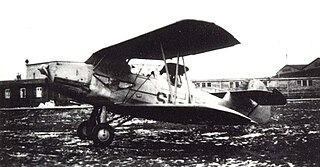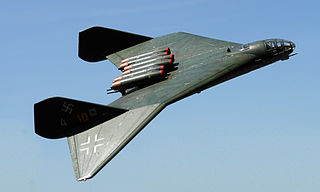
The Arado Ar 80 was a pre-World War II fighter aircraft, designed by Arado Flugzeugwerke to compete for the Luftwaffe's first major fighter contract. The Ar 80 was uninspiring in terms of performance and also suffered a number of failures. The contest was eventually won by the Messerschmitt Bf 109, and the Ar 80 prototypes ended their days as test aircraft.

The Arado Ar 234 Blitz is a jet-powered bomber designed and produced by the German aircraft manufacturer Arado. It was the world's first operational turbojet-powered bomber, seeing service during the final years of the Second World War.

The Arado Ar 196 was a shipboard reconnaissance low-wing monoplane aircraft designed and produced by the German aircraft manufacturer Arado. It was the standard observation floatplane of the Kriegsmarine throughout the Second World War, and was the only German seaplane to serve throughout the conflict.

The Arado Ar 68 was a single-seat biplane fighter designed and produced by the German aircraft manufacturer Arado Flugzeugwerke. It was among the first fighters produced when Germany abandoned the restrictions of the Treaty of Versailles and began rearming.

The Arado Ar 240 was a German twin-engine, multi-role heavy fighter aircraft, developed for the Luftwaffe during World War II by Arado Flugzeugwerke. Its first flight was in 1940, but problems with the design hampered development, and it remained only marginally stable throughout the prototype phase. The project was eventually cancelled, with the existing airframes used for a variety of test purposes.
Arado Flugzeugwerke was a German aircraft manufacturer, originally established as the Warnemünde factory of the Flugzeugbau Friedrichshafen firm, which produced land-based military aircraft and seaplanes during the First and Second World Wars.

The Arado Ar 232 Tausendfüßler, sometimes also called Tatzelwurm, was a cargo aircraft that was designed and produced in small numbers by the German aircraft manufacturer Arado Flugzeugwerke. It was designed during the first half of the Second World War in response to a request by the Reichsluftfahrtministerium for a successor or supplemental transport aircraft to the Luftwaffe's obsolescent Junkers Ju 52/3m. The Ar 232 introduced, or brought together, almost all of the features now considered to be standard in modern cargo transport aircraft designs, including a box-like fuselage slung beneath a high wing; a rear loading ramp, a high-mounted twin tail for easy access to the hold and features for operating from rough fields. It was initially requested to be powered by a pair of BMW 801A/B radial engines, however, an alternative arrangement of four BMW Bramo 323 engines was adopted instead due to a lack of capacity.

The Arado Ar 64 was a single-seat biplane fighter designed and produced by the German aircraft manufacturer Arado. It was among the first fighters produced when Germany abandoned the restrictions of the Treaty of Versailles and began rearming.

The Arado Ar 66 was a single-engined twin-seat training biplane designed and produced by the German aircraft manufacturer Arado. It was the last aircraft to be designed by the aeronautical engineer Walter Rethel in collaboration with Arado.

The Arado E.555 was a long range strategic bomber proposed by the German Arado company during World War II in response to the RLM's Amerikabomber project. The E.555 designation was applied to a series of long range jet bomber designs of various sizes, powerplant, crew and weapon load configurations. As design studies only, no aircraft were developed or constructed and the entire E.555 project was cancelled at the end of 1944.

The Arado Ar 96 is a single-engine, low-wing monoplane of all-metal construction, designed and produced by the German aircraft manufacturer Arado Flugzeugwerke. It was the Luftwaffe's standard advanced trainer throughout the Second World War.

The Arado Ar 95 was a single-engine reconnaissance and patrol biplane designed and produced by the German aircraft manufacturer Arado.

The Arado Ar 81 was a German prototype dive bomber. Because the Reich Air Ministry decided to purchase the competing Junkers Ju 87, only three prototypes of the Ar 81 were completed.

The Arado E.381 was a proposed parasite fighter aircraft. Conceived by Arado Flugzeugwerke in December 1944 for Germany's Luftwaffe during World War II, the E.381 was to have been carried aloft by and launched from an Arado Ar 234 "mother" aircraft. It would then have activated its rocket engine, which would have propelled it to attack Allied bombers. Development was cancelled due to lack of funds and official support.

The Arado Ar 198 was a prototype reconnaissance aircraft, developed by Arado Flugzeugwerke, with backing from the Luftwaffe, who initially preferred it over the Blohm & Voss BV 141 and the Focke-Wulf Fw 189. However, when flight tests were carried out the aircraft performed poorly and did not impress the Luftwaffe. One aircraft was completed in 1938.
The Arado Ar 233 was a 1940s German design for a civil twin-engined amphibian flying boat, developed by Dewoitine in France under the control of Arado Flugzeugwerke.

The Arado Ar 77 was a German twin-engined monoplane, designed as an advanced training aircraft from 1934.
The Arado E.583 was a project design from 1945 for a jet-powered night fighter aircraft of the German manufacturer Arado Flugzeugwerke.














